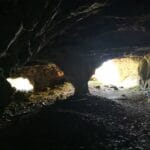
Mining on Hidra started in the 1850s and the last mine closed down around 1930. The most accessible mine is located at Urstad and is the only mine on the island that has been secured.
Hidra was covered in ice during several ice ages. The last ice melted 12,000 years ago. The island is dominated by granite with some elements of moraine in the mountains.
People have lived on Hidra for thousands of years, and there are several traces of the mining industry on Hidra. It was mainly feldspar and quartz that were extracted from the mines, but we also find traces of many other minerals, such as biotite and muscovite (crow silver), magnetite (magnetic), ilmenite (white pigment), garnets (various types) and the radioactive mineral aeschynite.
The mines are part of a pegmatite dyke. Pegmatite is a very coarse-grained rock that is usually formed by crystallisation of residual solutions of magma. This residual solution may contain some water and many different exciting minerals can be formed. Metre-sized crystals can be found in pegmatites. On Hidra, feldspar and quartz were in several places completely visible in the day in coarse-grained passages called pegmatite passages.
The Urstad mine has finally been made accessible to the public, and a good car park has been established and signs put up where you can read about the history of the mines on Hidra.
Category:
Flekkefjord, Geopark, Hidra, Historic places, cultural, Magma Geopark Sites
See more experiences in Magma Geopark